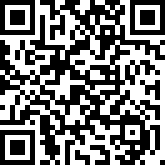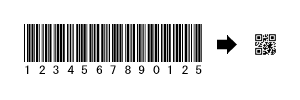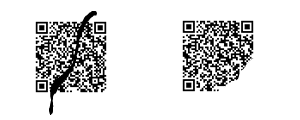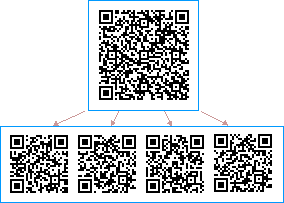 "Transitions" - From bar code symbology to 2D digital matrix QR Code symbology. Image Credit: DENSO WAVE
"Transitions" - From bar code symbology to 2D digital matrix QR Code symbology. Image Credit: DENSO WAVEQR Code - The Best Auto ID Code Ever, Really!
In the worlds of automatic identification and information technology, the question of what is the best machine-readable information-packed symbology ever ... has been answered.
Why?
Well, until someone comes up with a device-readable code that can hold nearly twice as much information as the next available code option, have the code achieve a move tolerance of about two meters a second (approximately six feet a second), and have the code repair itself with as much as 30% of the code image missing ... then one cannot dispute this claim!
The best auto ID code ever?
The best automatic identification code (symbology) ever is the QR Code, developed by Denso Wave (a Toyota Group Company). The QR Code was originally intended for use in tracking the complex task of automobile parts manufacturing and sourcing throughout the automobile assembly process.
This code, which was proprietary, has been an open source solution for years (first standard approval by AIM in 1997) and has found great favor in many application quarters, but the early adapters have mostly been found in the confirmation of cellphone-purchase transaction-verification and entry security.
The QR Code uses a true two-dimension (2D) digital matrix pattern symbology as opposed to a high-density or stacked barcode image approach. This code is read by image reading digital cameras as opposed to a single beam of light reading back upon itself in order to sense the reflectivity of an image through a "wave pattern" (laser). The strength of an image reading digital camera device is that they are solid state (no moving parts, which relates to increased reliability) and the imager can read ALL symbologies regardless of image/symbology approach.

As for use in the information technology marketspace (legal, insurance, medical, shipping and etc.), we at Symblogogy ask; what could be a better tool than a full mini traveling database for document identification information and dynamic file indexing?
Excerpts from Denso Wave (Japan) -
Bar code to 2D Code
Bar codes have become widely popular because of their reading speed, accuracy, and superior functionality characteristics.
As bar codes became popular and their convenience universally recognized, the market began to call for codes capable of storing more information, more character types, and that could be printed in a smaller space.
As a result, various efforts were made to increase the amount of information stored by bar codes, such as increasing the number of bar code digits or laying out multiple bar codes.
However, these improvements also caused problems such as enlarging the bar code area, complicating reading operations, and increasing printing cost.
2D Code emerged in response to these needs and problems
2D Code is also progressing from the stacked bar code method (that stacks bar codes), to the increased information density matrix method.
About QR Code
QR Code is a kind of 2-D (two-dimensional) symbology developed by Denso Wave (a division of Denso Corporation at the time) and released in 1994 with the primary aim of being "a symbol that is easily interpreted by scanner equipment".
QR Code (2D Code) contains information in both the vertical and horizontal directions, whereas a bar code contains data in one direction only. QR Code holds a considerably greater volume of information than a bar code.
In addition to QR Code, some other kinds of 2D Code have been developed. Below is a table of typical 2D Code and their features.
Reference Table Here>>
[Example shows that the QR Code data capacity for numeric data only is 7,089 characters and the alphanumeric data capacity is 4,296 characters. In comparison, the next closest code option is the DataMatrix Code by RVSI Acuity CiMatrix. The data only capacity is rated at 3,116 characters while the alphanumeric data capacity is set at 2,355 characters.]
QR Code provides the following features compared with conventional bar codes.
High Capacity Encoding of Data
While conventional bar codes are capable of storing a maximum of approximately 20 digits, QR Code is capable of handling several dozen to several hundred times more information.
QR Code is capable of handling all types of data, such as numeric and alphabetic characters, Kanji, Kana, Hiragana, symbols, binary, and control codes. Up to 7,089 characters can be encoded in one symbol.
 Small Printout Size
Small Printout Size
Since QR Code carries information both horizontally and vertically, QR Code is capable of encoding the same amount of data in approximately one-tenth the space of a traditional bar code. (For a smaller printout size, Micro QR Code is available. Kanji and Kana Capability (RoW communication capability)
Kanji and Kana Capability (RoW communication capability)
As a symbology developed in Japan, QR Code is capable of encoding JIS Level 1 and Level 2 kanji character set.
In case of Japanese, one full-width Kana or Kanji character is efficiently encoded in 13 bits, allowing QR Code to hold more than 20% data than other 2D symbologies.
Dirt and Damage Resistant
QR Code has error correction capability. Data can be restored even if the symbol is partially dirty or damaged. A maximum 30% of codewords can be restored.  Readable from any direction in 360 degrees
Readable from any direction in 360 degrees
QR Code is capable of 360 degree (omni-directional), high speed reading. QR Code accomplishes this task through position detection patterns located at the three corners of the symbol. These position detection patterns guarantee stable high-speed reading, circumventing the negative effects of background interference.
Structured Append Feature
QR Code can be divided into multiple data areas. Conversely, information stored in multiple QR Code symbols can be reconstructed as single data symbols.
One data symbol can be divided into up to 16 symbols, allowing printing in a narrow area.
For 2D Code to become widely used, it is first necessary for QR Code specification to be clearly defined and made public. In addition, QR Code must be freely usable by users.
The background [story] behind the popularity of bar codes, is specification disclosure [open source]. Today, there are very few bar codes with closed specifications or strict patent protection.
QR Code is open in the sense that the specification of QR Code is disclosed and that the patent right owned by Denso Wave is not exercised.
Standards References Here>>


1 comment:
Brand Attention QR code mobile seo application
We think QR codes are great here at Brand Attention, however most aren't using them as effectively as they could be. This is because most qr codes that people create send the user scanning it to a website not optimised for mobile platforms, meaning these sites often do not display as they should and are extremely difficult to navigate.This can be seen the the new pet shop boys video.
Brand Attention solves this by creating dedicated mobile sites expertly designed to work on any mobile device, and always display correctly making for good functionality and easy navigation.
For more information please go to Brand Attention Mobile SEO and QR Code Applications
or to see an example mobile site, go to Brand Attention QR Code Mobile Site
Brand Attention's other services include Mobile Search Engine Optimisation, QR Code Applications, SEO, PPC, Brand Management and Brand Protection
Post a Comment